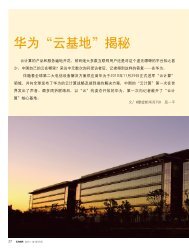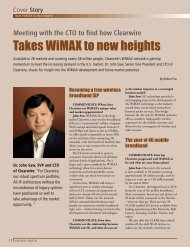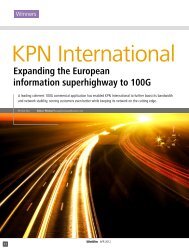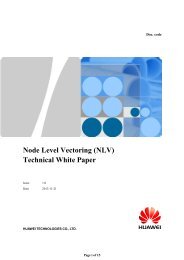EMOBILE: the mobile broadband revolutionist - Huawei
EMOBILE: the mobile broadband revolutionist - Huawei
EMOBILE: the mobile broadband revolutionist - Huawei
You also want an ePaper? Increase the reach of your titles
YUMPU automatically turns print PDFs into web optimized ePapers that Google loves.
The entire network solution is not just focused on traditional<br />
networking abilities, such as bandwidth allocation and packet forwarding.<br />
Through integration of computing and storage, network capabilities will be<br />
stronger and more practical.<br />
services; <strong>the</strong> terminals are for presentation of services;<br />
and <strong>the</strong> networks between <strong>the</strong> two components are <strong>the</strong><br />
plumbing or pipeline for information transmission.<br />
Many people are indifferent to <strong>the</strong> role of a network<br />
plumber, thinking that <strong>the</strong> ability to provide enhanced<br />
value-added network services should be <strong>the</strong> keynote for<br />
telecom operators to forge <strong>the</strong>ir core competitiveness. But,<br />
<strong>the</strong> Internet is a highly risky, highly profitable industry<br />
where only a fortunate few can mine <strong>the</strong> gold; while <strong>the</strong><br />
requirements for traffic bearing infrastructure keeps on<br />
growing regardless of concepts, making it lucrative for <strong>the</strong><br />
plumbers.<br />
For fixed <strong>broadband</strong> networks, <strong>the</strong> number of end users<br />
is calculated by households; however, in <strong>mobile</strong> Internet,<br />
<strong>the</strong> customer base is calculated by individuals, who may<br />
have multiple Internet terminals. Therefore <strong>the</strong> number<br />
of terminals to access <strong>the</strong> Internet will be larger by order<br />
of magnitude. The data package of <strong>the</strong> T-Mobile G1<br />
phone, which supports HSDPA, is priced at USD25 per<br />
month, equivalent to <strong>the</strong> monthly bill from AT&T for<br />
1.5M DSL <strong>broadband</strong>. This just might be <strong>the</strong> reason why<br />
both T-Mobile and AT&T are quite enthusiastic about<br />
merely being plumbing contractors and introducing <strong>the</strong><br />
G1 phone and <strong>the</strong> iPhone respectively and exclusively in<br />
North America.<br />
Operators can introduce Internet experiences and<br />
related technologies to <strong>the</strong>ir services, particularly HD video<br />
services, to take full advantage of local resources, including<br />
infrastructure and user information and to improve <strong>the</strong><br />
service ability of All-IP networks and increase profitability.<br />
Content distribution network (CDN) technology and<br />
location-based precise advertising technology can <strong>the</strong>n<br />
be introduced into Multi-Play bearer network solutions.<br />
This reduces <strong>the</strong> pressure on bandwidth for large scale<br />
video transmission and improves <strong>the</strong> experience of end<br />
users, while improving <strong>the</strong> ability of revenue generation of<br />
services and opening up more revenue streams for telecom<br />
operators.<br />
The entire network solution is not just focused on<br />
traditional networking abilities, such as bandwidth<br />
allocation and packet forwarding. Through integration<br />
of computing and storage, network capabilities will<br />
be stronger and more practical. With <strong>the</strong> standard<br />
optimization for digitalized information (XML/Flash/<br />
H.264/etc), <strong>the</strong> new network of “networking + computing<br />
+ storage” is able to perceive services and contents; an<br />
understanding of both bit and byte information. Only in<br />
this manner can a telecom operator do a superb job as a<br />
plumber, while trying to create new services and business<br />
models using <strong>the</strong> network as an information circulation<br />
platform and improving its IQ and EQ.<br />
There are two sides of Internet commercialization: It<br />
not only brings about both opportunities for start-up<br />
business and improved experiences for consumers, but<br />
also opens <strong>the</strong> door to those who profit from invading<br />
customers’ privacy or maliciously misguiding <strong>the</strong><br />
customers via spam, viruses, spyware, malware, and misuse<br />
of personal information. More and more websites are<br />
trying to influence consumers by page layouts and various<br />
information rating and ranking technologies, such as paid<br />
placement, search engine optimization (SEO) etc. These<br />
are all aimed to direct traffic to a select group of sites,<br />
limiting <strong>the</strong> choices for casual users.<br />
Apparently, <strong>the</strong>se negative aspects damage <strong>the</strong><br />
creditability of <strong>the</strong> Internet and loosen <strong>the</strong> cornerstone of<br />
Internet advertising. Google took “Don’t Be Evil” as its<br />
motto after it became popular, to alleviate any concerns,<br />
especially since Google has <strong>the</strong> best resources to be evil<br />
only if it wanted to.<br />
The overwhelming success of Google is a testament to<br />
<strong>the</strong> adage that, Internet commercialization is a double-edged<br />
sword, and playing business integrity is <strong>the</strong> only way to ensure<br />
<strong>the</strong> sound development of <strong>the</strong> Internet industry.<br />
Editor: Li Xuefeng xuefengli@huawei.com<br />
FEB 2009 / Win-Win<br />
20

















